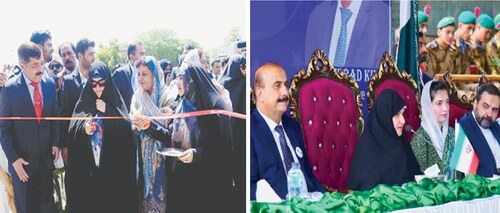ISLAMABAD: The Embassy of Japan on Monday hosted an exhibition of Japanese art and dolls as part of its celebrations of the 65th anniversary of diplomatic relations with Pakistan.
Japanese Ambassador Takashi Kurai and his wife Reiko Kurai hosted the exhibition at the ambassador’s residence.
“Today’s exhibition aims to introduce you to traditional Japanese woodblock prints, Japanese dolls and a few Japanese Shishu, or stitches,” the ambassador said.
“Woodblock printing stared in Japan during the Aska period, between 593 and 710, mainly to introduce and spread Buddhist text and painting. However, Japanese woodblock painting flourished and developed into art and a form of amusement during the Edo period in the early 17th century, between 1603 and 1868, and today this painting technique is used all over the world,” he added.
The ambassador explained that the difference between western and Japanese woodblock painting is that oil-based ink is used in western paintings and water-based ink is used in Japanese ones which give a different impression of the end product.
The small exhibition introduced Japan’s traditional woodblock prints developed in the Edo period and displayed representative dolls which have been a part of everyday life in Japan since ancient times. Dolls have been important to the Japanese culture for centuries and reflect the history of Japan from prehistoric to modern times.
The Japanese word for the dolls is ningyô which essentially translates to ‘in human shape’ and is therefore more than the doll but an anthropomorphic representation of something more.
Traditional Japanese dolls have been used over time for every purpose from national festivals, purification rites, medical applications, theatrical endeavours, to important gifts of state and supplications and prayers. In Japan, over the past millennia, the making of human figures has been popular in different ways, such as the talisman, the sacred object, the souvenir and the plaything. Dolls, for the Japanese, have spiritual significance; they seal friendships, protect or purify those who use them, and some find space in special occasions.
The variety of dolls represented the wide range of styles and forms that have evolved over the 13,000 years that dolls have been central to Japanese culture. They are also an admirable showcase for traditional Japanese craft products, such as textiles. The exhibition gave visitors a close glimpse of the versatility and individuality of the traditional and cultural life of Japanese people through these artistic handmade objects.
With the display ranging from Kokeshi dolls that originated as play things to warrior dolls and imperial palace dolls, the viewers were fascinated by the diversity of the types and the intricacy with which each had been made. Materials as diverse as wood, reeds, paper and porcelain were dressed in the finest cloth, often woven or painted especially with appropriately tiny motifs offsetting the Nihon Shishu or traditional Japanese embroidery also on display.
The curator of the show, Saba Hussein said the exhibition aimed to introduce traditional Japanese woodblock prints and traditional Japanese dolls to the Pakistani people.
Pakistan National Council of Arts Executive Director Jamal Shah said, “Japanese woodcuts have been a source of inspiration for modern Western art with impressionists and expressionists such as Van Gogh, Gaugin, and Lautrec drawing inspiration from them. If you look at some of these century-old prints on display here you can see that they are still highly modern. Their work is amazing and reflects their attempts to touch perfection.”
Published in Dawn, February 21st, 2017














































Dear visitor, the comments section is undergoing an overhaul and will return soon.